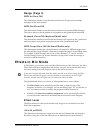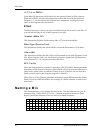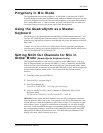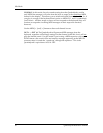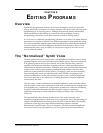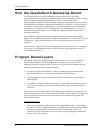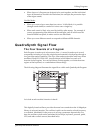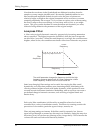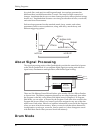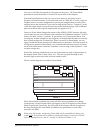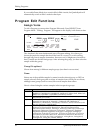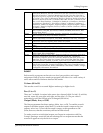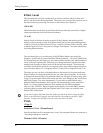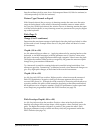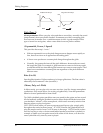
Editing Programs
QuadraSynth Reference Manual 55
About Modulation
modifies some aspect of a sound over time. Since oscillators make static sounds
(unlike acoustic instruments, whose timbre and dynamics changeÑoften radicallyÑ
over the duration of a note), modulation is the key to making rich and expressive
sounds. The vibrato of a flute, the expression pedal of an organ, a wah-wah pedal on
a guitar--all of these are examples of modulation. You're probably familiar with the
mod wheel of a synthesizer, that typically adds vibrato to a Program as it is raised.
But in synthesizer programming, modulation is used to control even the basic
characteristics of a voice: its attack, decay, and release times, for example. Every box
in the signal diagram on page 51 pointing towards the Voice, Filter, or Amp boxes is
a modulation source. The amount of modulation, the time it takes place, and what
controls (such as key velocity, footpedals, aftertouch, mod wheel etc.) affect it are
important parameters in every Program. The QuadraSynth provides the modulation
flexibility of patch cord-based instruments, but with the convenience and ease of use
of digital technology.
With some parameters, the modulation amount can be positive or negative. A
positive control signal increases the value of the parameter being controlled. A
negative control signal decreases the value of the parameter being controlled. Setting
modulation to 00 turns off the modulation source. Example: Keyboard velocity can
either make a sound brighter the harder you play, or make it less bright, or have no
effect on the filter at all. You have the freedom to set modulation any way you want,
even in ways that are the opposite of what they would be on an acoustic instrument.
If a "baseline" setting exists for a parameter, modulation amounts add or subtract
values from the existing setting. However, modulation cannot force a value beyond
its maximum range. For example, if the amp is already at its minimum value (lowest
level), you could apply positive modulation to raise the level. But applying negative
modulation will not affect the amp level, since it's already at its lowest value and
cannot go any lower.
The QuadraSynth lets you assign several modulation sources to one modulation
ÒtargetÓ parameter, which allows for interaction between two modulation signals.
Example: If the amp parameter responds to both the envelope generator and a pedal,
the parameter will follow the general envelope shape but will also be influenced by
the pedal.
(Low Frequency Oscillator)
The pitch, filter, and amp modules each have a dedicated LFO module for
modulation. The term LFO stands for low frequency oscillator, and comes from how
modulation was created in the early synth days (an oscillator set to a low frequency
could modulate some aspect of the sound; routing the LFO to the pitch, for example,
would create vibrato). The LFO creates a cyclic (periodic) modulation; this amount
can be constant and/or varied with a variety of modulation sources (mod wheel is
one of the most popular). Each LFO has a waveform shape and speed, along with
other controls.
Envelopes
generators provide a modulation signal that varies over time, from the time you
strike the key until after you let go. There are three independent envelope generators



